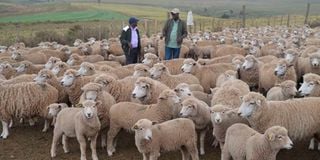Premium
Know the deadly sheep diseases

Jackson Nkurumwa (left), the livestock manager, and Joseph Ole Nkaiwuatei, the chief executive of Purko Development Trust on their farm in Ole Tips, Narok County.
What you need to know:
- All mammals, including human beings, are susceptible to tetanus.
Black leg is an acute disease of cattle and sheep that causes sudden death.
Many people are aware of the groups of micro-organisms that cause diseases in animals such as viruses, fungi and bacteria, but few take interest in specific organisms.
There are many species of the micro-organism that cause many diseases in several livestock species and also humans. Today, we look at clostridium bacteria diseases in sheep.
Clostridia
Bacteria in this category prefer an environment that is free of oxygen (anaerobic). They are commonly found in the soil and intestinal tract of animals and people. Under favourable conditions, the bacteria become infectious and cause disease. Transmission of the bacteria is either through wound contamination or ingestion of contaminated feed. The good thing about clostridia infection in sheep is that there is an affordable vaccine in the market that protects against all the common diseases caused by the bacteria.
Tetanus
All mammals, including human beings, are susceptible to tetanus but birds require a very high dose to get infected. Horses, donkeys and sheep are exceptionally vulnerable. The bacteria gain entry into the body during castration, dehorning, tail docking or through a stab wound. They produce a toxin which circulates in the body causing muscle rigidity starting from those next to the wound. The muscles become stiff such that one may think the animal is made of joint-less metal structure.
If the neck muscles are affected, the head is pulled backwards over the spine, a condition which is scientifically referred to as opisthotonus. If the face muscles are affected, the animal cannot chew as the jaws cannot move, a condition referred to as lock jaw. Most cases of tetanus are either confused with mineral and vitamin deficiencies or they go unreported as the animals are slaughtered or disposed of at the early stages of the disease.
Control of tetanus:
A sterile environment for all surgical procedures including open and closed castration and tail docking. Open operation implies that there is cutting and bleeding of the involved organ while closed involves use of tools such as rubber rings to castrate and tail dock.
Use Iodine disinfectant to sanitise wounds in animals.
Vaccinate animals against tetanus.
This has been done successfully in sheep due to incorporation of the tetanus vaccine in enterotoxaemia vaccine, which is used to control pulpy kidney. The vaccine can also be used in other animals such cattle, camels and goats.
If a case of tetanus is reported early enough, wound treatment, general antibiotic cover, general anaesthesia and a toxoid can save the animals.
At times, animal health service providers have been forced to use the toxoid used for humans due to its availability and affordability.
Black leg
This is an acute disease of cattle and sheep that causes sudden death and also produces sponge like feel to swollen muscles such as those of the shoulder and upper thigh. Upon cutting, affected muscles appear black hence the name of the disease. The illness is controlled through vaccination.
Braxy/big head
This is a firm swelling of head, neck and face of rams due to fighting or hitting at objects. It is also associated with dipping immediately after shearing.
Black disease
Two to four-year-old animals are affected by the disease and they tend to lag behind the flock. The animals then lie down and death follows. The disease is common in animals that are also affected by liver flukes. Disease causes blood capillaries below the skin to rupture resulting in accumulation of blackish blood clots in this area. The black colour gives the disease its name of black disease.
Enterotoxaemia (Pulpy kidney)
Although the disease can affect any age of sheep, it mostly hits lambs less than two weeks of age or at weaning (3-4 months). Well-nourished animals are highly vulnerable and sudden death is the major clinical sign. Rapid post-mortem changes take place in kidneys, changing their firm feel to a soft consistency and hence the name pulpy kidney.
Vaccinate lambs born by non-vaccinated mothers at 10 days of age and revaccinate 3-4 weeks later, while those from vaccinated mothers should be vaccinated at 7-8 weeks and a booster given 3-4 weeks later. Pregnant females should be vaccinated 4-6 weeks before lambing.
Lamb dysentery/struck
It affects lambs less than three weeks of age while struck affects adult sheep. Both diseases are acute in nature with bloody diarrhoea being the dominant clinical sign in the former and sudden death being the only sign in the latter.
Dr Mwirigi is a livestock production specialist. rivavet@yahoo





